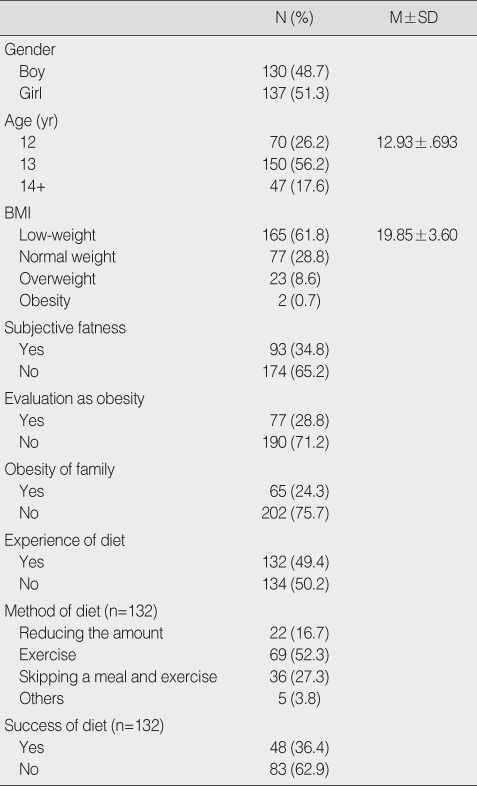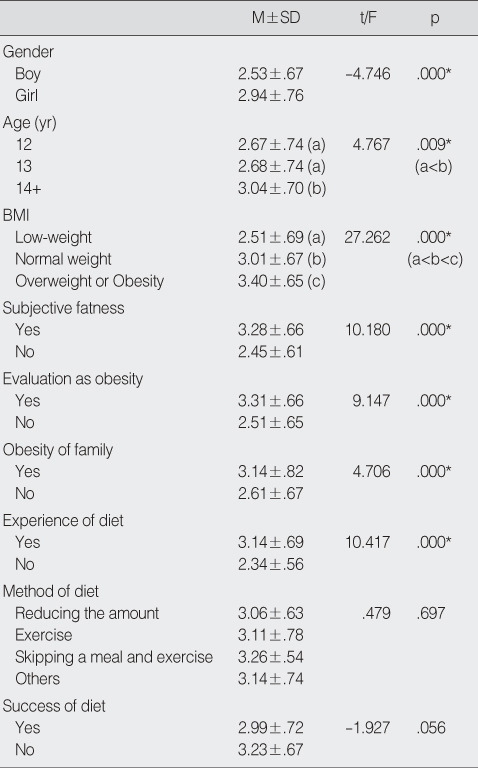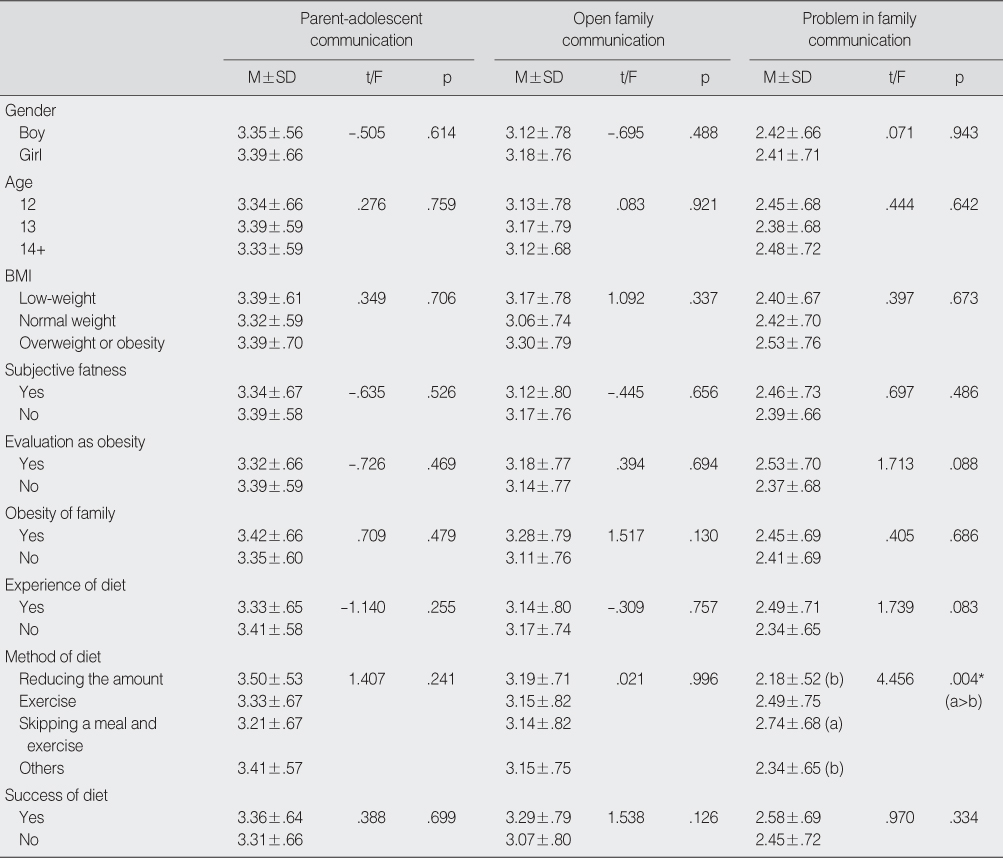Articles
- Page Path
- HOME > J Korean Acad Nurs > Volume 38(1); 2008 > Article
-
Original Article
- The Relationship between Eating Disorders and Parent-Adolescent Communication in Middle School Students in Rural Areas
- Kye-Ha Kim, Kyoung-Mi Yang
-
Journal of Korean Academy of Nursing 2008;38(1):55-63.
DOI: https://doi.org/10.4040/jkan.2008.38.1.55
Published online: February 28, 2008
1Full-time Instructor, Department of Nursing, Chosun University, Gwangju, Korea.
2Assistant Professor, Department of Nursing, Joongbu University, Geumsan, Korea.
- Address reprint requests to: Kim, Kye-Ha. Department of Nursing, Chosun University, 375 Seoseok-dong, Dong-gu, Gwangju 501-759, Korea. Tel: 82-62-230-6326, Fax: 82-62-230-6329, kyeha@chosun.ac.kr
• Received: October 25, 2007 • Accepted: November 19, 2007
Copyright © 2008 Korean Society of Nursing Science
Abstract
-
Purpose
- The purpose of this study was to examine the relationship between eating disorders and parent-adolescent communication in middle school students.
-
Methods
- There were 267 adolescents taken as participants from two middle schools in rural areas. Data were collected from June to July 2005, using the Eating Disorder Inventory-2 questionnaire (23 items) and Parent-Adolescent Communication Inventory (10 items for open family communication, 10 items for problem in family communication). The SPSS Win version 12.0 was used for descriptive analysis, t-test, and partial correlation coefficient.
-
Results
- The mean score on the eating disorder was 2.74 (range: 1-6). Meanwhile, the mean scores on the parentadolescent communication was 3.37 (range: 1-5). There were significant differences in eating disorders according to gender, age, negative perception of the participant's body weight, family's perception of obesity, diet experiences, and BMI. Eating disorders showed a significant negative correlation with parent-adolescent communication.
-
Conclusion
- In this study, there was a significant negative correlation between eating disorders and parent-adolescent communication. In order to prevent an eating disorder, education and training to enhance communication skills should be provided to adolescents and their parents as well.
- 1. American Psychiatric Association. Diagnostic and statistical manual of mental disorders. 1994;4th ed. Washington, DC, Author.
- 2. Arcelus J, Button E. Characteristics of university students referred to an eating disorders service. Eur Eat Disorders Rev. 2007;15:146–151.
- 3. Baek KS, Kwon YS. The effect of parent-adolescent communication types on the adaptation of adolescent school life. J Adolesc Welf. 2004;6(2):87–99.
- 4. Barnes HL, Olson DH. Olson DH, . Parent-adolescent communication Scale. In: Family inventories: Inventories used in a national survey of families across the family life cycle. 1982;St paul, Family Social Science, University of Minnesota.
- 5. Bas M, Kiziltan G. Relations among weight control behaviors and eating attitudes, social physique anxiety, and fruit and vegetable consumption in Turkish adolescents. Adolescence. 2007;42:167–178.PubMed
- 6. Choi EJ. The meta-analysis about the related variables of eating disorder. 2005;Daegu, Kyungpook National University. Unpublished master's thesis.
- 7. Drug diet, it is dangerous to adolescents. Weekly chosun, 1970. 2007;09 03 retrieved from http://weekly.chosun.com.
- 8. Galvin KM, Brommel BJ. Family communication: Cohesion and change. 1986;2nd ed. Glenview, Ill, Scott, Foresman.
- 9. Garner DM, Olmsted MP, Polivy J. Development and validation of a multidimensional eating disorder inventory for anorexia nervosa and bulimia. J Eat Disord. 1983;2:15–33.Article
- 10. Hong YL. Stressor, coping style, communication with mother & school adaptation in 6th grade elementary school children. J Korean Acad Child Health Nurs. 2000;6:362–371.
- 11. Hur CS, Yang MC. The relationships between parentchild communication types and their ego-state. J Stud Guid. 2006;27(1):15–36.
- 12. Kim YH. The interrelationship between the juvenile delinquency and the couple relationship, parent-adolescent communication, and family functioning. 1990;Seoul, Sook Myung Women's University. Unpublished doctoral dissertation.
- 13. Kim SH. Research of juveniles's problematic behavior- Focusing on the communication pattern between parents and children and on the problematic behaviors of peer group-. 2003;Gyeongsan, Yeungnam University. Unpublished master's thesis.
- 14. Kim JY. A study on the factors related to perception on body image, weight control attitude, and dietary behaviors in Korean adolescents by body image satisfaction. 2006;Seoul, Chung-Ang University. Unpublished master's thesis.
- 15. Kim YS, Kong SS. A study on weight-control behaviors, eating disorder symptoms and depression among female adolescents. J Korean Acad Psych Mental Health Nurs. 2004;13:304–314.ArticlePDF
- 16. Kong IS, Lee EJ, Lee JL. Adolescents' conflict, communication with parents and their self-concept. J Korean Living Sci. 2005;14:925–936.
- 17. Lee IS. Eating and dieting style of college women. Korean J Clin Psychol. 1997;16(1):87–100.
- 18. Lee JY. Eating disorder of women in their twenties case study. 2007;Seoul, Ewha Womans University. Unpublished master's thesis.
- 19. Lee KH, Kim SK, Chun KJ, Han SH. The relationship between eating disorder and self-esteem in female college students. Korean J Women Health Nurs. 2003;9:390–399.ArticlePDF
- 20. Machado PP, Machado BC, Goncalves S, Hoek HW. The prevalence of eating disorders not otherwise specified. Int J Eat Disord. 2007;40:212–217.ArticlePubMed
- 21. Ogden J, Steward J. The role of the mother-daughter relationship in explaining weight concern. Int J Eat Disord. 2000;28(1):78–83.ArticlePubMed
- 22. Park SH. A study on the communication of internet addicted youth. 2002;Jeonju, Jeonju University. Unpublished master's thesis.
- 23. Pesa JA, Turner LW. Fruit and vegetable intake and weight-control behaviors among US youth. Am J Health Behav. 2001;25(1):3–9.ArticlePubMed
- 24. Senra C, Sanchez-Cao E, Seoane G, Leung FYK. Evolution of self-concept deficits in patients with eating disorders: The role of family concern about weight and appearance. Eur Eat Disorders Rev. 2006;15:131–138.Article
- 25. Soh NL, Touyz SW, Surgenor L. Eating and body image disturbances across cultures: A review. Eur Eat Disorders Rev. 2006;14:54–65.Article
- 26. Song MR, Ahn HY, Kim EK. A study on the correlation between stress, mother-adolescent communication and quality of life in the adolescence. J Korean Acad Child Health Nurs. 2002;8:141–151.
- 27. Sohng KY, Park CS. Eating habits, trend of disordered eating, weight reduction practice and body size evaluation of college students in Seoul. Korean J Women Health Nurs. 2003;9:457–466.ArticlePDF
- 28. Sung MH. Relationship between eating disorders, physical symptoms, depression and health locus of control among elementary school girls in South Korea. J Korean Acad Nurs. 2004;34:576–585.ArticlePDF
- 29. Sung MH. Factors influencing eating disorders of college women. J Korean Soc Sch Health. 2005;18(1):71–82.
- 30. Vidovic V, Juresa V, Begovac I, Mahnik M, Tocilj G. Perceived family cohesion, adaptability and communication in eating disorders. Eur Eat Disoders Rev. 2005;13:19–28.Article
- 31. Yeoum SG, Jo JY, Kwon HJ, Kim KH, Young HM. A study on the relation of parent's child-rearing attitude, parent-child communication pattern and gender role identity. Korean J Youth Stud. 2005;12:19–38.
REFERENCES
Figure & Data
REFERENCES
Citations
Citations to this article as recorded by 

- Effects of Korean Enneagram Program on the Ego-identity, Interpersonal Relationship, and Self-leadership of Nursing College Students
Weon-Gyeong Kim, Hyang-In Cho Chung
Journal of Korean Academy of Nursing Administration.2015; 21(4): 393. CrossRef - Impact of Sport-related Games on High School Students’ Communication Skills
Ozden Tepekoylu Ozturk, Selhan Ozbey, Hatice Camliyer
Physical Culture and Sport. Studies and Research.2015; 67(1): 53. CrossRef - A study on the effect of emotional intelligence on adjustment to college life in first year nursing college students
Hyun Tae Park
Journal of the Korea Academia-Industrial cooperation Society.2014; 15(3): 1576. CrossRef - Testing the Biobehavioral Family Model in Understanding the Eating Problems of Adolescent Girls.
Ji Young Park, Su Yon Baek, Hee Soon Kim, Jung Ha Lim, Tae Hyung Kim
Child Health Nursing Research.2013; 19(3): 228. CrossRef - Interpersonal Relations, Hope, Professional Self-concept and Turnover Intention according to Adult Attachment Styles in Early Stage Nurses
Eun Jin Oh, Se Young Lee, Kyung Mi Sung
Journal of Korean Academy of Nursing Administration.2013; 19(4): 491. CrossRef - A Study on the Correlation between Middle School Students' Eating Disorder Behavior and Scholastic Adjustment
Joo-Yeon Yoo, Yang-Ho Jin, Se-Jeong Bae
Korean Journal of Community Nutrition.2012; 17(6): 707. CrossRef - Eating Attitudes, Depression, Parent-child Interaction, and Family Function of Adolescent Girls
Suyon Baek, Jiyoung Park, Heesoon Kim, Taehyung Kim
Journal of Korean Academy of Psychiatric and Mental Health Nursing.2012; 21(3): 176. CrossRef - Effects of Child-rearing Attitude and Parent-School Age Communication on Self-Efficacy of School-age Children
Yeon Ran Hong
Journal of Korean Academy of Child Health Nursing.2009; 15(4): 392. CrossRef
The Relationship between Eating Disorders and Parent-Adolescent Communication in Middle School Students in Rural Areas
The Relationship between Eating Disorders and Parent-Adolescent Communication in Middle School Students in Rural Areas
General Characteristics (N=267)
Eating Disorder and Parent-Adolescent Communication
Eating Disorder by General Characteristics
*p<.01.
Parent-Adolescent Communication by General Characteristics
*p<.01.
Correlation between Eating Disorders and Parent-Adolescent Communication
*p<.05; †p<.01.
Table 1
General Characteristics (N=267)
Table 2
Eating Disorder and Parent-Adolescent Communication
Table 3
Eating Disorder by General Characteristics
*p<.01.
Table 4
Parent-Adolescent Communication by General Characteristics
*p<.01.
Table 5
Correlation between Eating Disorders and Parent-Adolescent Communication
*p<.05; †p<.01.
 KSNS
KSNS
 E-SUBMISSION
E-SUBMISSION





 Cite
Cite

